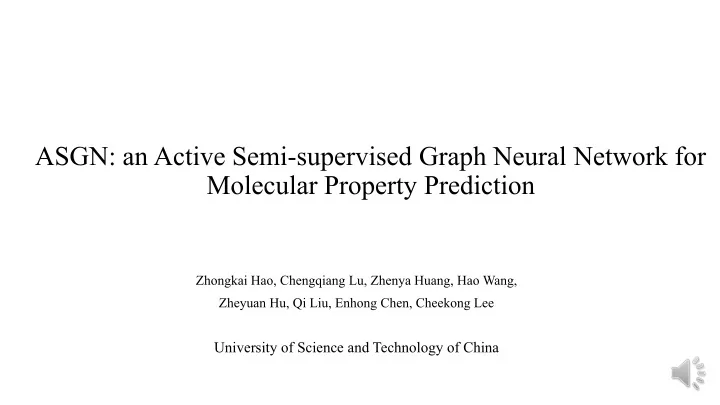

ASGN: an Active Semi-supervised Graph Neural Network for Molecular Property Prediction Zhongkai Hao, Chengqiang Lu, Zhenya Huang, Hao Wang, Zheyuan Hu, Qi Liu, Enhong Chen, Cheekong Lee University of Science and Technology of China
Introduction • Our task: Molecular property prediction Properties: U0 (Atomization energy at 0K) U (Atomization energy at room temperature) G (Free energy of atomization) HOMO LUMO . . Output: Properties . Input: Molecule • Applications: Drug discovery, material engineering…
Introduction • Measure properties by experiments • Density Functional Theory • Modern: Machine learning methods • A molecule as a graph( ! = ($, &) ) • Pass it to a message passing Graph Neural Networks • Get the result after 10 *+ seconds
Introduction • ML model is data hungry, requires many labelled data • Unlabelled data (molecular graph) is everywhere • Labelling is expensive • Our goal: label efficient model !: # → % & • Our Solution: Active semi-supervised learning
Preliminaries—GNN for molecular property prediction • Pass message from nodes to nodes • Aggregate node to get the graph representation GraphSAGE: A popular MPNN
Related Work—Semi-supervised Learning • Number of labeled data ≪ unlabeled data • How can we make use of unlabeled data ? • Create pseudo labels and predict them! The influence of unlabeled data
Related Work—Active Learning • Active learning is to improve the value of these labels • Choose data that is helpful to the model and retrain the model • Solution: most representative and diversified subset in the dataset Framework of active learning.
Challenges • Data structure of molecules is different from traditional images/text/… • Few works on semi-supervised learning of molecules • Low training efficiency because of the imbalance data
Model Framework • Two GNN, a teacher and a student model • Train the teacher with semi-supervised learning • Train the student with fully supervised learning for downstream property prediction
Teacher Model • Local(node) level pseudo labels—reconstruction • We believe a good property predictor is able to recover the atom itself from its embedding • A loss function to reconstruct atom and their distance - GNN Sample and reconstruct
Teacher Model • Global level pseudo labels—clustering loss • Implicit clustering via optimal transport • Predict these clusters and repeat iteratively
Teacher model • Summary of the teacher model • Add these three loss terms to guide its optimization (1).property loss (2).reconstruction loss (3).clustering loss ! " : labeled data ! # : unlabeled data
Student model • Weight transfer from the teacher model • Fine tune on property prediction task • Accelerate convergence and alleviate loss conflict
Active Data Selection • Choose most informative data • K center to choose one molecule from one cluster • Add them into the labeled dataset • Repeat the process until label budget is used up Selection via k-center
Experiments • Datasets (1) QM9: 130,000 molecules, <9 heavy atoms (2) OPV: 100,000 medium sized molecules • Properties (All calculated by DFT) (1) QM9: (2) OPV:
Experiments • Effectiveness, compare error on test dataset • Baselines (1).Supervised (2).Mean-teachers (3).InfoGraph
Experiments • Results Results on QM9 Results on OPV
Experiments • Efficiency, the label efficiency at a certain error • Baselines: (1).Random (2).Query by Committee (3).Deep Bayesian Active Learning (4).Vanilla K-center
Experiments • Results
Experiments • Ablation Study • Why using two models (a teacher and a student) Visualization • Why transferring weight from the teacher to the student • Visualization experiment Necessity of teacher and student Necessity of weight transfer
Many thanks!
Recommend
More recommend